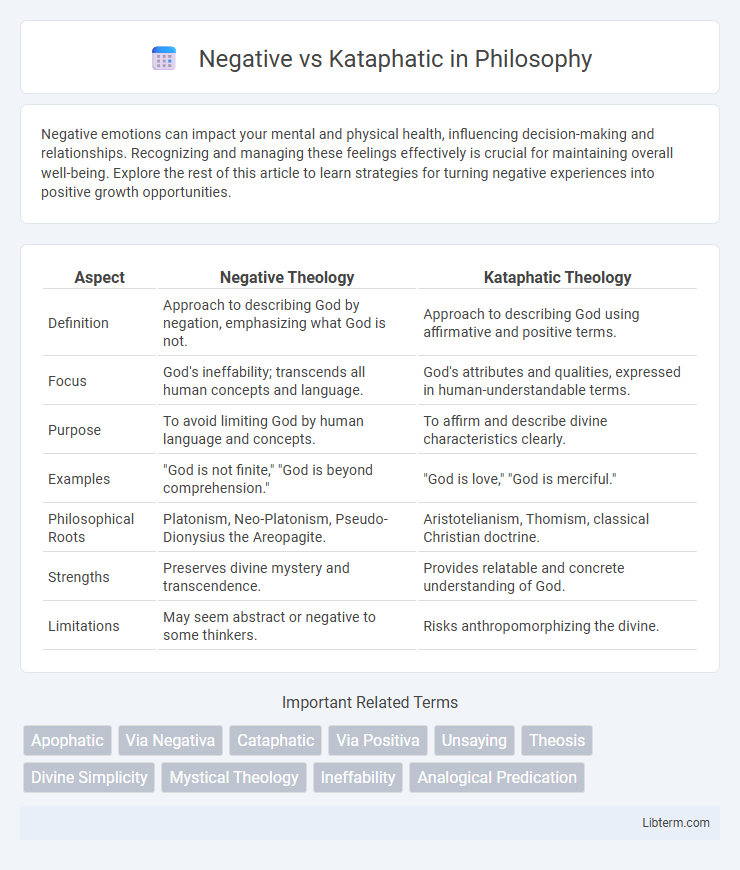Negative emotions can impact your mental and physical health, influencing decision-making and relationships. Recognizing and managing these feelings effectively is crucial for maintaining overall well-being. Explore the rest of this article to learn strategies for turning negative experiences into positive growth opportunities.
Table of Comparison
| Aspect | Negative Theology | Kataphatic Theology |
|---|---|---|
| Definition | Approach to describing God by negation, emphasizing what God is not. | Approach to describing God using affirmative and positive terms. |
| Focus | God's ineffability; transcends all human concepts and language. | God's attributes and qualities, expressed in human-understandable terms. |
| Purpose | To avoid limiting God by human language and concepts. | To affirm and describe divine characteristics clearly. |
| Examples | "God is not finite," "God is beyond comprehension." | "God is love," "God is merciful." |
| Philosophical Roots | Platonism, Neo-Platonism, Pseudo-Dionysius the Areopagite. | Aristotelianism, Thomism, classical Christian doctrine. |
| Strengths | Preserves divine mystery and transcendence. | Provides relatable and concrete understanding of God. |
| Limitations | May seem abstract or negative to some thinkers. | Risks anthropomorphizing the divine. |
Understanding Negative and Kataphatic Approaches
Negative and Kataphatic approaches represent distinct ways of perceiving and describing concepts, especially in theology and philosophy. The Negative approach, often called apophatic, emphasizes understanding by negation, focusing on what cannot be said about a subject, thereby acknowledging its mystery and ineffability. The Kataphatic approach relies on positive affirmations and direct descriptions, highlighting attributes and qualities to provide a clearer, more tangible understanding of the subject.
Definitions: What is Negative Theology?
Negative Theology, also known as apophatic theology, defines God by what cannot be said about the divine essence, emphasizing divine ineffability and transcendence. It asserts that human language and concepts fall short of describing God directly, thus God is understood through negation--what God is not--rather than positive attributes. This approach contrasts with kataphatic theology, which employs affirmations and positive statements to describe the nature of God.
Defining Kataphatic Theology
Kataphatic theology emphasizes the positive affirmation of God's nature through human language, symbols, and analogies, aiming to describe divine attributes with affirming statements. In contrast, negative theology, or apophatic theology, focuses on what cannot be said about God, highlighting divine mystery by negating human descriptors. Defining kataphatic theology involves recognizing its approach to understanding God by using affirmative, meaningful terms to express the divine essence while balancing human limitations in theological expression.
Historical Roots of Both Traditions
Negative theology originated in early Christian mysticism, notably shaped by Pseudo-Dionysius the Areopagite, emphasizing the ineffability of the divine by describing what God is not. Kataphatic theology, with roots in classical Greek philosophy and early Church Fathers like Augustine, asserts knowledge of God through positive affirmations and descriptions. Both traditions have deeply influenced medieval scholasticism and continue to shape contemporary theological discourse.
Key Figures and Texts in Negative Theology
Negative theology, also known as apophatic theology, is chiefly associated with key figures such as Pseudo-Dionysius the Areopagite, whose works including "The Mystical Theology" emphasize the ineffability of God by defining divinity through negation. Gregory of Nyssa and Johannes Scottus Eriugena further advanced this tradition by stressing the limitations of human language in capturing the divine essence. Central texts in negative theology employ paradox and negation to express the transcendence of God, contrasting with kataphatic approaches that describe God through positive affirmations.
Major Proponents of Kataphatic Thought
Major proponents of kataphatic thought include St. Augustine, whose writings emphasize the positive articulation of God's nature through divine attributes, and Pseudo-Dionysius the Areopagite, who developed a nuanced framework combining kataphatic theology with apophatic insights. Thomas Aquinas further advanced kataphatic theology by systematically using analogical language to describe divine essence and human understanding of God. These thinkers significantly shaped kataphatic theology's core principle: knowing God through affirmative descriptions grounded in scripture and philosophical reasoning.
Core Differences: Language and Divine Mystery
Negative theology emphasizes describing the divine by what it is not, using apophatic language to highlight the ineffability and transcendence of God beyond human comprehension. Kataphatic theology employs affirmative language, attributing positive qualities and names to the divine to express God's immanence and relational aspects. The core difference lies in their linguistic approach: negative theology fosters divine mystery through negation and silence, while kataphatic theology reduces that mystery by affirming God's attributes through symbolic and metaphorical expression.
Implications for Spiritual Practice
Negative theology emphasizes the ineffability of the divine, encouraging practitioners to embrace silence and humility in spiritual practice. Kataphatic theology uses positive affirmations and imagery to connect believers with God, fostering relational intimacy and meditation through concrete symbols. The interplay of both approaches deepens spiritual experience by balancing transcendence with immanence in contemplative disciplines.
Contemporary Debates and Perspectives
Contemporary debates on negative versus kataphatic theology center on the balance between describing the divine through negation and affirming positive attributes. Scholars argue that kataphatic approaches enable a more personal and relational understanding of God, while negative theology emphasizes divine transcendence and mystery. Recent perspectives highlight the complementary nature of both methods, suggesting an integrated framework that respects God's ineffability alongside meaningful affirmation.
Integrating Negative and Kataphatic Paths
Integrating negative and kataphatic paths involves balancing the apophatic approach, which emphasizes understanding the divine through negation and what it is not, with the kataphatic approach that describes the divine through affirmative attributes. This synthesis allows for a richer theological framework that acknowledges the limitations of human language while affirming positive expressions of faith and spiritual experience. Embracing both paths fosters a deeper, more nuanced comprehension of the divine, bridging mysticism and doctrine in spiritual practice.
Negative Infographic

 libterm.com
libterm.com